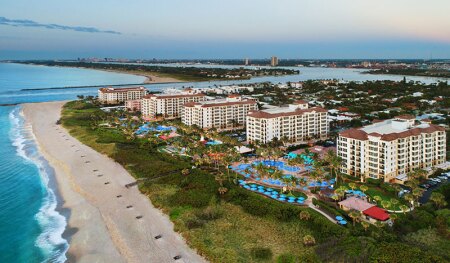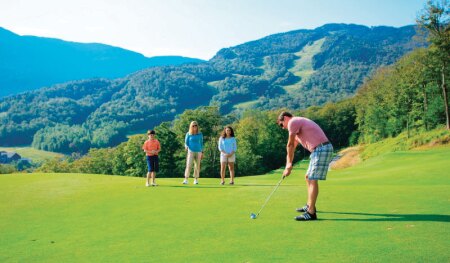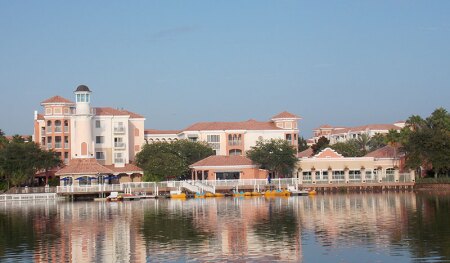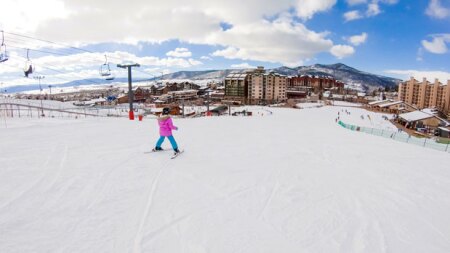ULI MEMBER–ONLY CONTENT: Distinguished placemakers discuss how resort and recreation developments can adapt to consumers’ changing priorities.
While the full health and economic effects of the COVID-19 outbreak remain to be seen, this much seems clear: for the short term, or pre-vaccine period, resort business owners and managers need to balance the imposition of new precautions, procedures, and, sometimes, restrictions with the need to present an inviting, stress-free environment.
What also is clear: drive-to leisure destinations, which typically are favored over fly-to destinations during economic downturns, have become even more popular due to the COVID-19 outbreak, which has made people reluctant to travel in the close quarters of airplanes.
Less clear are the long-term implications of the crisis, such as how it might ultimately cause some people to rethink their priorities, lifestyles, and living and working environments.
Dynamic or Distant?
The type of behavior advised by medical professionals to limit the spread of the virus—specifically, social distancing—is, ironically, the very opposite of what placemaking strives for, which is to foster a sense of community by bringing people together through thoughtful design that encourages socializing and connecting.
Former ULI Global Chairman Peter Rummell, whose placemaking career spans decades, points to beachfront communities as an example. “I’ve never developed a beach resort where we did not plan everything around a beach club. It’s the place where people come together, they hang out over food and drinks, and that club is counterintuitive to everything you would do today,” says Rummell, chairman of RummellMunz Partners in Jacksonville, Florida.
“Do you keep designing bars the way we know bars? Does the new bar have only tables spaced six feet [1.8 m] apart that sit four people? That is an example of a fundamental change based on people’s behavior.”
Other factors, Rummell notes, include housing considerations such as whether to build more multistory buildings requiring elevator access or more townhouses with individual entrances to minimize points of contact.
Deciding what to change or not change is a significant economic issue that “can be very complicated and expensive if you are wrong,” he says.
The current environment is “probably the most complicated time” due to the unknowns about vaccine availability as well as consumer behavior, such as whether people will start to vacation in larger groups to fill up space that might otherwise be occupied by strangers, Rummell says. “There is no track record for solutions or alternatives. A year from now, things will be much clearer. Depending on people’s actions and behavior based on this experience, there could be a need for a whole new series of products to accommodate this new world.”
Until the virus is contained, “we are going to see significant caution in all aspects of life, including resorts,” predicts ULI Life Trustee James DeFrancia, principal and president of community development at Lowe Enterprises, headquartered in Los Angeles. Resorts that are within driving distance of urban areas and offer activities that lend themselves to natural social distancing will likely be the most appealing, says DeFrancia, who is based in Steamboat Springs, Colorado.
“Urban, high-density resorts such as casinos where people are shoulder to shoulder are going to suffer in the near term, because there is going to be an aversion to those kinds of environments,” he notes. “I think people are going to be drawn to more remote areas where they can stay in cabins or other lodging facilities that are not as densely populated, where it is easier to maintain social distancing, where people can enjoy outdoor activities such as hiking, fishing, and horseback riding, and not be in confined environments.”
Because COVID-19 has been found to affect older adults particularly severely, accommodating multiple generations at resorts could, for the short term, require special consideration, DeFrancia notes. “That will sort itself out, as consumers who are sensitive to that environment look for resorts that will accommodate their desires for separate lodging that allows them [separate generations] to get together periodically, but not be cheek by jowl for the duration of the vacation.”
A long-term change, DeFrancia notes, will likely be a heightened focus on health and wellness by consumers as well as the resort industry. “We could see an expansion of wellness-focused resort communities and a refinement of those that already exist,” he says. “Having been through a pandemic, people are more mindful of health now, and that will translate into resort communities being responsive to changes in [people’s] awareness and behavior.”
Maintaining Confidence
Marriott Vacations Worldwide, which holds the exclusive licenses to the Westin, Marriott, Sheraton, and Hyatt vacation ownership brands, started to reopen many of its leisure properties in North America, says Lani Kane Hanan, executive vice president and chief development and product officer for the Orlando, Florida–based company.
In addition to rigorous cleaning and disinfecting protocols, the reopening process has involved instituting changes such as installing more pool cabanas, reconfiguring outdoor and indoor furniture to accommodate social distancing, moving all group activities such as exercise classes outside, hosting movie and family events outdoors, replacing communal spaces with smaller gathering “pods,” and removing from villas unnecessary items such as decorative bedding and furniture.
They also are exploring changes to children’s programs that might involve having counselors provide individualized experiences for families rather than hosting group activities.
“We are creating an environment where families can be together, but separate,” Kane Hanan says. “People are craving a sense of togetherness, but they want their own space.” The desire to spread out—to have sufficient space that permits people to enjoy each other’s company but stay apart from other groups—is a trend that is likely to last after the pandemic subsides, she notes. “Just as 9/11 forever changed how we go through [airport] security, there will be changes that will stick. People will continue to demand enhanced cleanliness and green practices, and they will want elbow room.”
In addition to making changes in its existing resorts, the company is considering some design changes for property refurbishments and new properties, including rebuilding pool decks with tiered levels that can accommodate more chaises and cabanas spaced further apart, larger elevators and door openings, and, in villas, the use of materials that can withstand frequent disinfecting and are naturally resistant to bacteria. The company is also exploring touchless technology for services ranging from pool towel retrieval to elevator use—technology that Kane Hanan says could also enhance the company’s sustainability initiatives.
Such steps will make a big difference in maintaining consumer confidence that health is a top priority for each property, she says. “Vacations aren’t going away; they are sacred. And we need to make people feel as safe at our vacation properties as they do when they walk into their own home. Our job is to give people hassle-free, unforgettable vacation memories.”
Palmetto Bluff, a resort community in South Carolina’s Lowcountry near the Atlantic Coast, experienced a surge in residents this past spring as the virus peaked in many states, with property owners driving there to quarantine in their second homes, says David O’Donoghue, president and chief executive officer of the resort. Palmetto Bluff’s hotel and guest cottages were closed during that time, but in late May, just before the partial reopening of those properties and resumption of guest services, preparations were underway for ramped-up safety measures, including resort employees wearing personal protection equipment.
According to O’Donoghue, the expectation was that incoming and returning guests, particularly those from states with a high number of COVID-19 cases, “would be very used to seeing people in masks and gloves,” but that the experience “might be unnerving” for existing residents who were more accustomed to “business as usual” at Palmetto Bluff.
“We want to protect our employees, residents, and guests, and from day one [of the crisis], we have communicated frequently about health and safety protocols, and we have issued calls to action regarding people taking personal responsibility for being safe and complying with social distancing measures,” he says. Initial occupancy of the guest lodging was limited to units with exterior entrances, restaurant and pool occupancy was capped at 50 percent of capacity, and fitness center access was by appointment only.
The reopening of the hotel and cottages necessitated employee training on ways to instruct guests and residents about safety precautions, O’Donoghue notes. “In our industry, we are not used to telling people [resort occupants] what to do, but we are going to have to do that for a period of time.”
Long-term changes will include an emphasis on touchless, contactless services, such as switching from paper to phone apps for everything from marketing collateral to room service menus, he says. Individual room air circulation systems are being explored for guest rooms and cottages, and they could be offered as options for new homes built in the community, he notes. Plans are underway for a continuing care/wellness component that is being expanded to include a concierge physician and an on-site pharmacy, O’Donoghue says. The emphasis on all aspects of health “will continue to evolve,” he adds, enhancing the appeal of the community.
Making New Choices
One result of the coronavirus pandemic could be the revival of golfing communities, which fell out of favor during the 2008 recession and have struggled to make a comeback, in part due to rising consumer interest in less time-consuming activities. “It could be that golf is going to come roaring back, because it is designed for social distancing—it’s played outside and in small groups,” says Rummell.
“We came out of the last recession and said, ‘We can’t make time for golf, it takes us away too long from our families and the office,’” notes Samuel Gaines, president of Spruce Peak Realty in Stowe, Vermont, and managing director at AIG Global Real Estate Investment Corporation. Now, with people seeking activities that keep them apart from others, “even in states that have just barely opened up the spigot for economic activity, golf is one of the first things to come back,” he says.
At the Spruce Peak resort, one of the golf courses reopened in May, and demand for tee times has been “tremendous,” Gaines notes. Golf may evolve from a “going-out-with-buddies” activity to one that is more oriented toward families (including shorter rounds) as an additional outdoor option, he says.
At resort communities, the short-term focus is about meeting members’ basic needs, Gaines adds. “People want easy access—to be able to just get in their car and go to their place. They want to be sure that health, safety, and security are prioritized. They want access to social distance–friendly recreation. And, they want space, inside and outside.”
One example of a commitment to maintaining expectations is providing top-quality takeout and in-room meals as an extension of the fine-dining experience that has been a centerpiece of resort developments, he notes. “We are not going to eat out as much as we did before. But we will want that connectivity with amazing cuisine, and excellent to-go offerings is a service that resort communities can provide.”
For the long term, Gaines believes that resort communities will play a key role in the creation of a new work/leisure paradigm due to the prevalence of telecommuting from home to avoid exposure to COVID-19. More people who own second homes in resorts will likely work from those homes and spend less time in the office, he predicts.
“With the ability to work away from the office, people will ultimately spend more time where they want to be, rather than where they think they need to be,” Gaines says. “We are discovering that we can manage our work schedules differently and take off the shackles of office commuting. It’s liberating.”
“People are attending Zoom meetings who never would have thought of doing that a year ago. Instead, they would get on a plane and go somewhere to attend meetings—work meetings, board meetings, partner meetings. Now, we are all going to meetings electronically and are finding out that it isn’t hard to do and can be quite effective,” notes DeFrancia of Lowe Enterprises. “In the course of this crisis, we have learned that all kinds of work can be done that is not location-sensitive.”
In addition to people working more from their second homes, this could result in more people making resort communities their primary residences, he says.
The “mainstreaming” of working from home by a large segment of the population could significantly boost second-home sales, says ULI Recreational Development Council chairman Jeff Woolson, managing director of golf and resort properties for CBRE.
“Everyone I know who owns a second home has been there in this stay-at-home world, and the people who did not buy prior to the crisis are kicking themselves for not doing it,” says Woolson, who is based in Carlsbad, California.
“I think we will see a push to purchase second homes in great destinations that are within driving distances of urban areas. We have learned how to work from home better because we were all forced to do so,” Woolson says.
While there will be a need for face-to-face collaboration in office spaces, working from home has now become a reality for more workers than ever before, he notes. “All you need is great wi-fi in your second home to make that arrangement work.”
One trend that Woolson believes will last beyond the crisis is people’s desire to drive to resort and leisure destinations. This could spark an uptick in recreational vehicle (RV) parks designed as “mini-resorts” that cater to people who enjoy driving to different places on one extended trip, he says, noting that CBRE is contemplating such a development.
“The idea is to create a high-end RV park with stalls for sale to vehicle owners, and which offers the amenities you would find at a resort. People would come in their huge motor homes and stay a while. That could be a different kind of resort that takes into account people’s desire to drive,” he says.
Recovering from the Downturn
Every crisis, economic or otherwise, “makes you smarter and more creative. You learn from it, you collaborate, and you adapt,” says former ULI Global Chairman Harry Frampton, chairman and founding partner of East West Partners in Denver.
“I have been through five major recessions [1974, 1981, 1989, 2001, and 2008], and while the downturn we are in right now is harsher and more serious in some respects than the others, I think we will come out of it quicker than the others because of the creativity and entrepreneurship of the people figuring out how to overcome this,” he says. “Every time we have had a recession, it seemed awful. But out of every single one, we came out better.”
Frampton points to several lessons emerging from the coronavirus crisis, including a deeper appreciation of the need to protect human health and environmental health; a recognition of the value of online teaching; and that time with family should not be taken for granted.
“My gut says we will come out of this feeling good about how we are applying what we have learned,” he says. “There may be a few bumps along the way, but we will figure out how to work in this new environment.”
Post–COVID-19, the winners will be great places—whether they are major cities or resort communities, Frampton says. “Will New York City be a great place? Yes. Will Vail [Colorado] be a great place? Yes. Not every city or every resort is going to be good. People will place a premium on great places. And great places have a sense of community, good infrastructure, great parks and open spaces, and an involved citizenry. The places that will prosper will be those with good fundamentals. In the long run, that is what will make a difference.”
TRISH RIGGS, former senior vice president of communications at ULI, is now a freelance writer based in Falls Church, Virginia.




